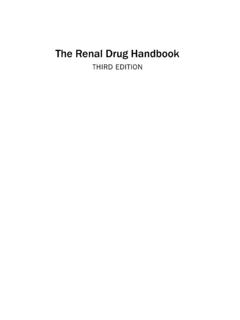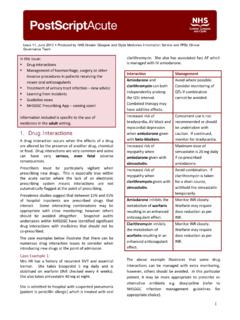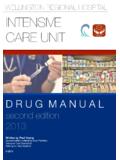Transcription of Second Meeting of the Subcommittee of the …
1 Second Meeting of the Subcommittee of the expert Committee on the Selection and Use of Essential Medicines Geneva, 29 September to 3 October 2008 Gentamicin - Ototoxicity in children Summary Aminoglycosides have good activity against many multi-drug resistant Gram negative bacilli and are therefore important for treating serious infections due to these organisms in adults and children including neonates. Use of these drugs can result in ototoxicity and nephrotoxicity. Ototoxicity is irreversible and may result in cochlear damage, vestibular damage or both. Incidence of cochlear and vestibular toxicity is low in children and neonates. There is no significant difference in the incidence of ototoxicity between once daily dosing and multiple doses per day. Limited available data show that aminoglycoside induced hearing loss contributes to only a small proportion of the deafness in the community.
2 Individuals with certain identifiable mutations have higher susceptibility to aminoglycoside induced hearing loss. Nephrotoxicity is largely reversible and its incidence is also low in children. However, aminoglycosides are to be used only when there is a definite indication and for the minimum duration required. Monitoring of drug levels and for toxicity is recommended. Most trials in children have used gentamicin. Cost of gentamicin is less than that of other aminoglycosides. Amikacin has almost similar spectrum and is also safe in children. It may be effective against some gentamicin resistant bacteria and so is more suitable for hospital settings where gentamicin resistance rates are high. Introduction Aminoglycosides are narrow spectrum antibiotics which act mainly on aerobic Gram negative bacilli including many multi drug resistant ones.
3 They are recommended for use in children including neonates for several serious infections like septicaemia, caused by these bacteria. However, aminoglycoside use can result in ototoxicity and nephrotoxicity. Other adverse events like antibiotic associated diarrhoea and hypersensitivity are rare [1]. Although gentamicin and amikacin have similar indications for use and safety profile in children, most reported experience is with gentamicn. It is also less expensive (International Drug Price Indicator Guide). Ototoxicity Animal and human studies show that aminoglycosides progressively accumulate in endolymph and perilymph of inner ear and that the half life in these fluids is 5 to 6 times greater that that of plasma half life [1]. Back-diffusion is dependent on concentration of the drug in plasma and hence, ototoxicity is more likely to occur in patients with persistently elevated concentrations in plasma.
4 However, even single doses can cause ototoxicity. Vestibular and cochlear sensory cells are susceptible to damage by aminoglycosides and the changes are largely irreversible. Hence ototooxicity can be cochlear and/or vestibular damage. Although all aminoglycosides are capable of affecting cochlear and vestibular functions, some preferential toxicity is evident. For example, gentamicin causes more vestibular damage while amikacin causes more auditory damage. Auditory damage is better recognised and often erroneously used synonymously with ototoxicity Hearing loss (Cochlear toxicity) By audiometry, about 25% of patients on aminoglycoside therapy develop toxicity [1]. Most studies in infants and children from different parts of the world however, show that hearing loss is a rare complication of aminoglycoside therapy [2-7]. Neither ototoxicity nor nephrotoxicity were noted in a Cochrane review [2] done to assess safety and efficacy of once daily (OD) dosing of gentamicin, based on 11 studies (n= 574) in neonates with sepsis.
5 Pharmacokinetic properties were better with OD regime in that it achieved higher peak levels while avoiding toxic trough levels. Only one study enrolled infants less than 32 wks gestation. Another meta-analyses [3] of 24 RCTs in children published between 1991 and 2003, found that the pooled toxicity rates by auditory testing were (10 of 436 cases) with OD and (8 of 406 cases) with multiple doses per day (MD) schedules. There were no cases of clinical hearing impairment (OD and MD 114 cases each). Hearing abnormalities were infrequent in neonates treated with aminoglycosides [4]. of low birth weight and very low birth weight infants on gentamicin had probable hearing abnormalities as detected using brainstem auditory response signals (ALGO screen). neonates in the control group also had a similar finding [8]. With amikacin no neonate had abnormalities in the brainstem auditory evoked potentials in one study on 40 neonates [9] and no difference from control neonates were observed in another [10].
6 Only one RCT in a metaanalyses of gentamicin therapy of UTI in children looked for toxicity by audiometry and none of the 172 children had this complication [5]. Measurements were done in the immediate post treatment periods for most of these studies. Although gentamicin is used widely in neonates, reports on hearing loss in such children in later life are scanty. This probably suggests relative absence of this problem. Limited data do not show any significant hearing loss in gentamicin and kanamicin treated infants on four year follow up [11]. In a clinic and school based survey in Nicaragua done to identify causes of deafness, earlier gentamicin use was recorded as a possible risk factor in a small number of children. However, most of these children had other risk factors also like meningitis and familial hearing loss [12]. A family history of hearing loss was the most frequent risk factor in this survey.
7 Some individuals have genetic predisposition for developing hearing loss and they can develop permanent hearing loss with therapeutic concentrations and even single doses of aminoglycosides [13]. About quarter of individuals with aminoglycoside induced hearing loss have maternal relatives with drug related hearing loss. Most common predisposing mutation identified is >G, which is a mitochondrial DNA mutation and hence exclusively maternally inherited [13]. This mutation is seen in up to 50% of aminoglycoside related hearing loss. No large scale data for its prevalence is available. In the US 1/1161 neonates had this mutation and in a report from New Zealand 1/206 random blood samples showed this mutaion. In the UK, 1/1000 children are born deaf and 2-5% of them have this mutation. Epidemiological studies suggest that probability of becoming deaf is very high if individuals with this mutation are exposed to aminoglycosides.
8 Hence to prevent aminoglycoside related hearing loss, one possibility is to screen for this mutation[13]. However the test is expensive, not easily available and can cause delays in initiating therapy. Asking for history of deafness in maternal relatives is more practical. Damage is mediated by reactive oxygen species that trigger mechanisms causing cell death. Antioxidants show promise in protecting inner ear from damage in experimental animals [14]. One double-blind, placebo controlled clinical trial showed that aspirin can reduce the incidence of aminoglycoside induced hearing loss in human beings [14]. Vestibular toxicity Vestibular function is much more sensitive to aminoglycosides than hearing [15]. Most individuals with vestibular toxicity do not develop hearing loss [16] and these cases are usually missed. Manifestations include gait imbalance and head movement induced oscillopsia[17].
9 Vertigo may or may not be present. This damage is also permanent [15]. This toxicity also appears to be rare in children and neonates. No vestibular toxicity was documented among 209 OD and 206 MD patients [3] in a metaanalyses of dosing schedules. 30 children aged between and m, who had received gentamcin in the neonatal period did not show increase frequency of spontaneous eye movements as compared to children without gentamicin exposure in neonatal period [18]. Nephrotoxicity Approximately 8% to 26% of patients who receive aminoglycosides for more than 7-10 days (Australian Medicines Handbook) develop mild renal impairment which is almost always reversible [1]. It usually presents as gradually worsening non oliguric renal failure. Severe acute tubular necrosis may occur rarely. Nephrotoxicity is also uncommon in children.
10 The Cochrane review did not identify any nephrotoxicity [2]. Other meta-analyses found low incidences of this toxicity [3-5]. There was no significant difference between OD (15 of 955 cases, ) and MD (15 of 923 cases, ) schedules in causing elevated creatinine levels or in reducing creatinine clearance in children. Urinary excretion of protein or phospholipids occurred in 3 of 69( ) cases on OD compared to 11 of 69 cases ( ) on MD (statistically significant RR , 95% CI: ) [3]. In one RCT, of the 172 evaluable cases (between 1m to 9yrs) on OD and on MD schedule had nephrotoxicity [5]. NAG/creatinine ratio was abnormal in 2/13 (15%) and 5/11 (45%) children in another RCT in the same meta-analysis [5]. No nephrotoxicity, as defined using creatinine levels, was recorded in 148 and 162 malnourished children on OD and MD gentamicin regimes [19].














